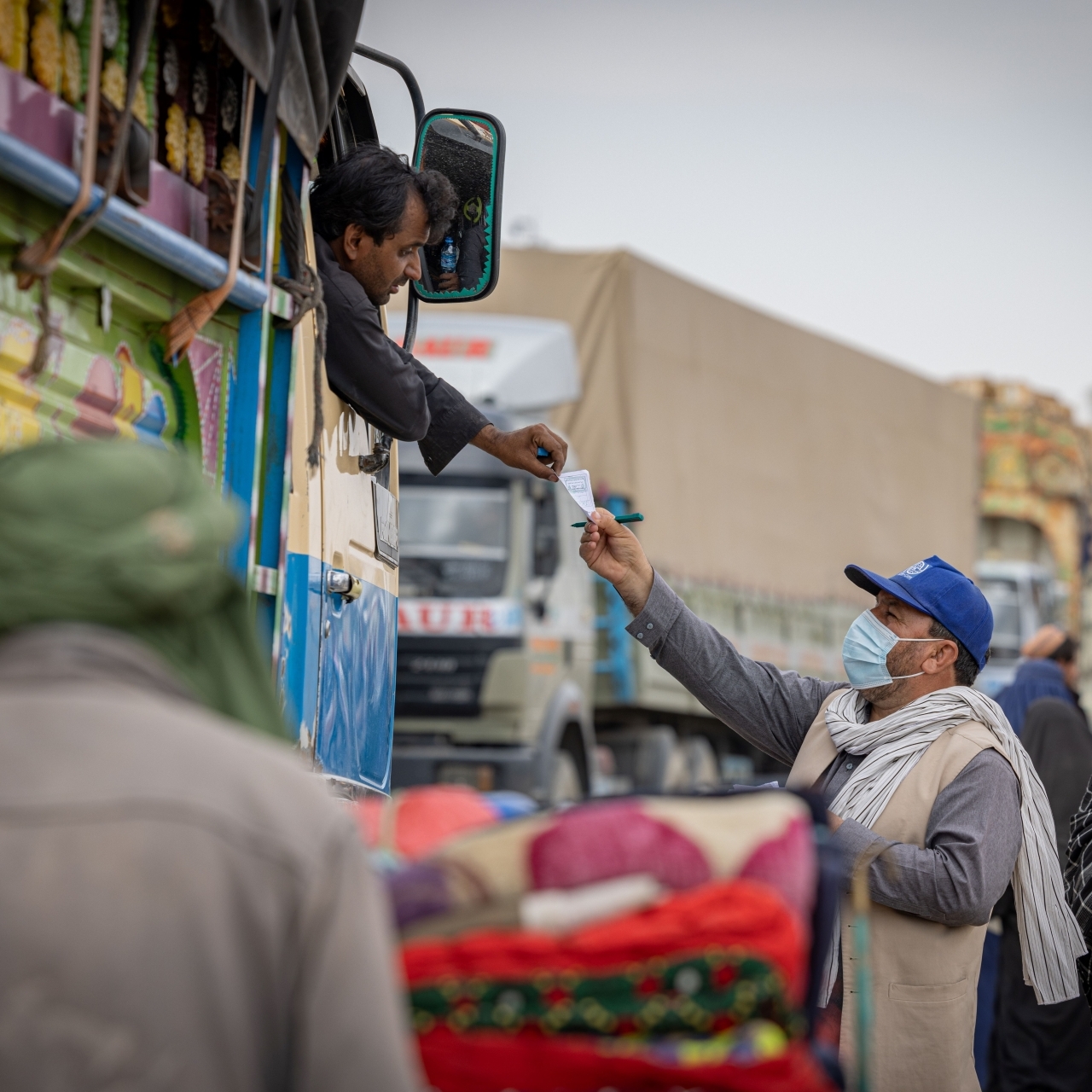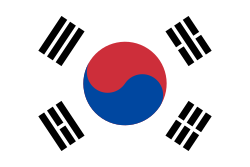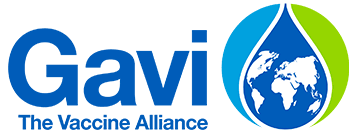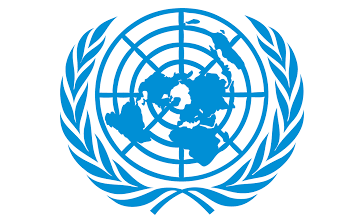IOM Vision
IOM’s strategic approach in Afghanistan will continue prioritizing life-saving multi-sectorial humanitarian and protection assistance across the country and in targeted border crossing points, while laying the foundation for durable solutions for voluntary and dignified return, recovery, and longer-term development efforts. IOM will prioritize gender-responsive programming, through gender analysis and interventions that focus on the inclusion and empowerment of women and girls.
Objective
Saving lives and protecting people on the move
IOM aims to deliver timely and effective multi-sectoral life-saving humanitarian assistance and protection to people on the move and affected populations in coordination with the Humanitarian Country Team and partners on the ground.
IOM utilizes its Displacement Tracking Matrix (DTM) tools to regularly track and monitor cross-border and in-country population mobility and associated trends, vulnerabilities, and needs to inform the humanitarian response on the ground. Information is critical to inform immediate and longer term response. To improve the information upon which the humanitarian response is conducted, multi-sectoral data collection regarding population movements, trends, needs, and priority gaps in service provision will be needed to inform decision-making and implementation of programming. IOM’s DTM operates through a network of more than 70,000 key informants and knowledge of displacement trends across the country will allow for rapid expansion.
This is implemented through a participatory approach involving the affected populations in all steps of programme cycles to promote a needs-based and inclusive response. The data collection, consolidation and analysis conducted will inform a range of information products, including the Afghanistan Mobility and Needs Assessment (previously the Baseline Mobility and Community Based Needs Assessments), Flow Monitoring at the four major border crossing points, Movement Snapshots, and rapid assessments in disaster-affected locations in the immediate aftermath of an incident.
IOM assists vulnerable undocumented Afghan migrants crossing one of four major land border crossing points (Nangahar, Kandahar, Herat, Nimroz) with cross-border post-arrival humanitarian assistance (CB-PAHA). IOM manages eight reception and transit centres at these border points. These centres will continue to provide assistance for vulnerable undocumented returnees including:
- Screening and registration, immediate post arrival assistance including meals, overnight accommodation for up to 72 hours, needed non-food items, multi-purpose cash grants, and referrals to relevant programmes.
- Serving as entry points for a range of critical IOM interventions such as protection, health, disease surveillance at the borders and humanitarian border management, as well as for other partners who also operate within the centres delivering other specialized services, such as mine risk education.
- Multi-purpose cash assistance to support returnees to cover their basic needs, such as overnight accommodation and food throughout their journey back to their destination of choice in-country with the objective to help them cope and reintegrate in their areas of return. This support will become even more essential given the current significant increase in Afghan returnees from Pakistan, which is expected to continue in 2024.
IOM will expand existing camp coordination and camp management (CCCM) operations in terms of capacity and coordination in the new displacement context, given the expansion of displacement sites and anticipated continuation of population movements following the Herat earthquakes.
This will include:
- Deployment of CCCM Mobile Teams to coordinate services with partners and support participation and information-sharing with communities, including monitoring services and advocating for unmet needs in the response to sudden onset disasters, ie. earthquakes or floods, as well as to perform emergency site improvements as appropriate and needed to ensure safe and dignified living conditions.
- Continued operation of IOM's established Community Resource Centres (CRCs), which serve as vital platforms for two-way communication, feedback and complaints, referrals, community engagement activities and coordination with humanitarian partners and other relevant stakeholders.
In order to respond to the increasing health needs of IDPs and other mobile populations, working in close coordination with the Health Cluster and partners, IOM will sustain and strengthen delivery of essential health care to serve both IDPs and vulnerable returnees, as well as vulnerable members of host communities. IOM will continue to deliver lifesaving primary and secondary health care services, including routine (and outbreak) vaccination, and provision of reproductive, maternal, child and adolescent health services. IOM support will include:
- Deploying mobile health teams to travel to and access hard-to reach communities, referring people to specialized services and dispensing free medicine and health supplies, including hygiene and menstrual hygiene management kits.
- Conducting health promotion and risk communication activities adapted to the epidemiological situation in Afghanistan, alongside demand generation for vaccinations. Rapid Response Teams will also be deployed for outbreak prone disease surveillance efforts, including screening, sample collection and testing, case management and referrals in underserved mobility corridors, border crossing points, IDP settlements and target institutions, such as public schools or hard-to-reach communities.
- Facilitating tuberculosis (TB) programming through active case finding in hard-to-reach communities, testing and enrolment in treatment.
IOM will implement community based MHPSS with an aim to promote, protect, and support the psychosocial well-being of the crisis-affected population in Afghanistan. Following the IOM Manual on Community-Based Mental Health and Psychosocial Support in Emergencies and Displacement, IOM will target both IDPs and vulnerable returnees, as well as vulnerable members of the surrounding host communities affected by the crisis. IOM activities will include:
- Deploying MHPSS counsellors as part of the migration health teams. The MHPSS counsellors will offer family and community support, facilitating socio-relational, cultural, creative, and art-based activities, in addition to focused psychosocial support through counselling, individual and family. Community awareness on MHPSS topics, psychoeducation and referral to the mental health specialized care are also part of the services.
- Conducting training for local stakeholders on the provision of psychological first aid (PFA), basic psychosocial skills and relevant MHPSS topics.
- Continuing to ensure that standards and procedures are followed, responses are coordinated, and that a common understanding is established among MHPSS response partners on MHPSS concepts and terms, eventually co -chairing subnational MHPSS working groups.
IOM Afghanistan works on addressing protection risks and specific needs of undocumented returnees to ensure their safety and dignity. This is carried out through the provision of tailored assistance at border points and in provinces of return. IOM protection interventions encompass post-arrival protection assistance; sustained case management support in areas of return; and protection monitoring, reporting, and advocacy. These efforts complement and support broader durable solutions planning for IDPs and returnees in Afghanistan. In 2024, IOM will expand its current protection case management and protection monitoring programme to support IDPs as well as returnees. The support will include:
- Continuing post-arrival protection assistance, including protection screening and referrals. Protection screeners at Herat and Nimroz border points will identify persons with specific needs (including women/children at risk, serious medical cases, persons with disabilities), and refer cases facing protection risks for post-arrival assistance – e.g. provision of information, referrals, and assistance including family tracing and reunification, emergency accommodation, and safe transportation to returnees’ chosen final destination.
- Continuing to conduct protection case management for undocumented returnees and IDPs households with persons with specific needs (including women or children at risk, serious medical cases, the elderly and persons living with a disability). Particularly, households will continue to be supported via dissemination of key protection information, referral to local services including MHPSS services, livelihood opportunities, and one-off assistance such as cash for protection to meet immediate needs and mitigate protection risks (e.g. resort to negative coping mechanisms such as begging, child labour, or child marriage).
- Regular protection monitoring (surveys, interviews and community discussions) will continue to be undertaken across all locations in coordination with the Afghanistan Protection Cluster to understand the protection environment for undocumented returnees and protection trends, monitor human rights violations, and support analysis to inform evidence-based advocacy for an effective protection and wider humanitarian response across Afghanistan. This protection monitoring will also support protection mainstreaming, including AAP and PSEAH, across all units of IOM.
Access to safe water continues to be most critical, particularly in the context of the severe water scarcity affecting most of the country and the October 2023 earthquakes. IOM will aim to provide crisis-affected households with sustained access to sanitary services to improve hygiene practices and prevent the transmission of diseases (including Acute Watery Diarrhea(AWD)/cholera), with a focus on the most vulnerable populations, including women, girls, and children with special needs. IOM will also provide technical and public health expertise to ensure timely and appropriate WASH response and services where needed. Activities will include:
- Establishing WASH facilities, such as emergency latrines and shower installations.
- Assessment, rehabilitation and expansion of water schemes.
- Management of water schemes through the creation of gender-balanced community-led WASH committees.
- Hygiene promotion and awareness-raising activities, focusing on risk mitigation measures for transmittable diseases, including COVID-19 and AWD/cholera.
- Provision of basic hygiene kits inclusive of menstrual hygiene management items.
The scale of displacement in late 2023 due to the series of earthquakes in Herat province in October 2023 required IOM to scale up its response amid limited stock supplies and capacity into 2024. IOM activities will include:
- Increasing its cash-based interventions (CBI) to address immediate winterization, shelter and NFI needs, contributing to cluster efforts to meet the urgent needs of people, support survival capacities, and prevent mortality. IOM will also expand CBI in general through cash for NFI, rent, transitional shelter and shelter repair.
- Pre-positioning and/or distribution of shelter materials.
- Pre-positioning and/or distribution of household items.
- Designing, setting up/construction of, and upgrading emergency shelters, including individual and collective accommodation options.
- Designing, setting-up/construction of, and upgrading of transitional/core shelters and housing.
- Continuing as Co-Chair of the Emergency Shelter and NFI Cluster, which also currently covers CCCM, to ensure a timely, well-coordinated, and cost-effective response in Afghanistan.
- In order to ensure a timely and efficient response, continuing to procure and preposition shelter and NFI to rapidly respond wherever there is a need across all 34 provinces. Specific emphasis will be placed on expanding CCCM operations capacity and coordination in the new displacement context, given the expansion of displacement sites and anticipated continuation of population movements following the Herat earthquakes.
Through its DTM, IOM will continue to monitor cross-border and in country population mobility, as well as trends, vulnerabilities, and needs associated with it, to inform the humanitarian response on the ground. This will be implemented using a participatory, inclusive and evidence-based approach involving the affected populations. IOM will conduct:
- Afghanistan Mobility and Needs Assessment on population mobility trends, numbers and locations of displaced and vulnerable populations, reasons for displacement, needs and gaps in access to services.
- Flow Monitoring at four major border crossing points, counting the number of daily movements, provinces of origin, destination, and reasons for movement.
- Rapid assessments in disaster-affected locations in the immediate aftermath of an incident to assess needs and impact. In cases of eviction, as there is sometimes knowledge in advance that one will take place, DTM will conduct a pre-return assessment.
- Through a Population Movement Task Team, work is also underway between IOM and UNHCR to harmonize displacement data across the country, focusing on protracted displacement and IDP returnees.

Objective
Driving solutions to displacement
IOM’s recovery and transition programming aims to enhance the resilience of individuals and communities by addressing the socioeconomic needs of returnees, IDPs, and vulnerable host populations in high-return provinces. IOM does this through three main pathways (voluntary return, local integration, or resettlement elsewhere), using area- and neighborhood-based approaches. IOM supports community stabilization by promoting community infrastructure projects; economic revitalization and sustainable livelihoods, especially for women; access to essential basic services, and community cohesion. IOM ensures that it implements activities that:
- Benefit both displaced or returned and host communities, while being responsive to the specific (re)integration needs of people on the move.
- Reduce the root causes of displacement and migration, by the strengthening social, economic and psychosocial resilience of displacement affected communities, considering vulnerabilities specific to gender, age, and ability, among others.
- Revitalize local economic conditions by supporting the business ecosystem and increasing human capital, thereby safeguarding existing jobs and creating new ones.
- (Re)construct productive and basic social service infrastructure, including health clinics and schools.
IOM Afghanistan will also target local communities, to enhance the resilience of communities at risk of natural hazards in Afghanistan, as well as NGOs and implementing partners working in the field of disaster management and humanitarian assistance. In communities that face a high risk of disaster and displacement and in line with the Sendai Framework, IOM supports disaster risk reduction (DRR) and disaster risk management (DRM) efforts through:
- Improving the preparedness of vulnerable populations living in disaster-prone areas with a focus on a holistic watershed management approach.
- Supporting communities to have improved infrastructure and access to water and preparedness mechanisms to protect farm-based livelihoods and cope with environmental and climate shocks and natural disasters.
- Enhancing watershed management research to support disaster risk management actions and capacity.
- Contributing to community early warning and preparedness systems to mitigate risk and enable a more effective response.
- Ensuring social cohesion and accessibility through designing livelihoods support initiatives and implementing livelihoods diversification strategies to promote social cohesion and inclusivity through community mobilization efforts prioritizing engagement with diverse groups.
IOM Afghanistan will primarily target local communities, to enhance the resilience and preparedness of communities at risk of natural hazards in Afghanistan, as well as NGOs and implementing partners working in the field of disaster management and humanitarian assistance.
IOM will accelerate delivery of area-based humanitarian, early recovery, reintegration and resilience projects across displacement and conflict-affected communities. This will include:
- Developing District/Provincial Profiles to guide evidence-based strategic and essential infrastructure projects, to provide communities with basic services while building community resilience to withstand shocks.
- Undertaking participatory community development and action planning to increase civic engagement, strengthen local ownership and identify context-specific solutions for addressing the vulnerabilities of different social groups.
- Supporting active collaboration and exchange among local stakeholders and community members, particularly vulnerable and marginalized groups, to enhance social cohesion and strengthen communities’ response capacities to shocks and stresses.
- Undertaking community-based monitoring and evaluation to promote legitimacy and accountability at the local level.
- Where possible, referrals of vulnerable individuals from IOM’s cross-border and protection programmes will be provided support upon their return to areas where stabilization or durable solutions activities are ongoing.
Livelihoods support, including as described under Livelihoods and Economic Recovery, is an integral part of Community Stabilization efforts.
IOM supports community infrastructure projects; economic revitalization and sustainable livelihoods, especially for women; access to essential basic services, and community cohesion. IOM implements the following activities:
- Support to community outreach activities to enhance trust and promote social cohesion at the local level.
- Provision of emergency livelihood assistance, including through cash-for-work on construction sites, asset replacement and emergency business grants in support of economic recovery.
- Support for gender responsive employment opportunities (which include opportunities for self-employment) for IDPs and their host communities.
- Small grants mechanism for targeted high return areas for community-driven programming.
- Information and advisory services on aspects related to forced displacement and return such as housing, land, property issues.
- Specific support to women and girls to achieve socioeconomic reintegration and foster socioeconomic independence.
IOM works to prevent, avert and address displacement related to natural hazards and climate change through improved disaster risk management, focusing on high-risk communities that are vulnerable to specific types of disasters and have limited access to early warning systems; in line with the Sendai Framework, IOM supports DRR and DRM and will:
- Supporting the establishment and strengthening of early warning systems to mitigate risk and enable a more effective response.
- Supporting the standardization of operational guidelines on DRR; and facilitating the development of community-specific disaster risk reduction plans including early warning systems and dialogue initiatives on mobility, risks, and resilience.
- Supporting the establishment of community-based DRR infrastructure in complementarity with the repair or construction of damaged or destroyed community infrastructure.
- Conducting hazard and vulnerability mapping and analysis to support communities further in DRM.
- Enhancing the resilience and preparedness of communities at risk of natural hazards in Afghanistan, as well as NGOs and implementing partners working in the field of disaster management and humanitarian assistance.
- Conducting research, hazard mapping, and multi-hazard risk assessments, including historical displacement trend mapping to inform future programming and identify areas of cyclical displacements, and development of contingency plans for the returns of Afghans from Pakistan and Iran.
- Engaging community members, local leaders, and relevant stakeholders in a participatory approach to identify and assess local hazards, vulnerabilities, and capacities, with a focus on technology access and literacy.
- Strengthening capacity of humanitarian partners and stakeholders on early actions strategies, protection measures, and policy development.
- Providing training and resources to empower community members on risk assessment, disaster preparedness, and the use of technology for early warning.
Afghanistan
The map used here is for illustration purposes only. Names and boundaries do not imply official endorsement or acceptance by IOM.
Figures are as of 31 December 2023. For more details of IOM's operational capacity in country, please see the IOM Capacity section.























